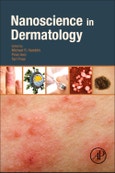Nanoscience in Dermatology covers one of the two fastest growing areas within dermatological science, nanoscience and nanotechnology in dermatology. Recently, great progress has been made in the research and development of nanotechnologies and nanomaterials related to various applications in medicine and, in general, the life sciences. There is increasing enthusiasm for nanotechnology applications in dermatology (drug delivery, diagnostics, therapeutics, imaging, sensors, etc.) for understanding skin biology, improving early detection and treatment of skin diseases, and in the design and optimization of cosmetics.
Light sensitive nanoparticles have recently been explored, opening a new era for the combined applications of light with nanotechnology, also called photonanodermatology. However, concerns have been raised regarding the adverse effects of intentional and unintentional nanoparticle exposure and their toxicity.
Written by experts working in these exciting fields, this book extensively covers nanotechnology applications, together with the fundamentals and toxicity aspects. It not only addresses current applications of nanotechnology, but also discusses future trends of these ever-growing and rapidly changing fields, providing scientists and dermatologists with a clear understanding of the advantages and challenges of nanotechnology in skin medicine.
Please Note: This is an On Demand product, delivery may take up to 11 working days after payment has been received.
Table of Contents
1. Anatomy and Function of the Skin Yolanda Gilaberte, Lucia Prieto-Torres, Ievgenia Pastushenko and Ángeles Juarranz
2. Fundamentals of Nanoscience (and Nanotechnology) G. Louis Hornyak and Anil K. Rao
3. An Overview of Nanomaterials in Dermatology Breanne Mordorski, Angelo Landriscina, Adam Friedman
4. Clinical Impact and Patient Safety: The Potential of Microneedles in Changing the Form and Perception of Transdermal Drug Delivery Aaron J. Brady and Ryan F. Donnelly
5. Inorganic nanoparticles for transdermal drug delivery and topical application Min Wang, Srujan Kumar Marepally, Praveen Kumar Vemula and Chenjie Xu
6. Biodegradable, Biocompatible and Bioconjugate Materials as Delivery Agents in Dermatology Fiorenza Rancan
7. Peptide Dendrimers in Delivery of Bioactive Molecules to Skin Jyothsna Menon, Aswathi R Hegde, Harendra S. Parekh and Srinivas Mutalik
8. Insights into Interactions of Gold Nanoparticles with the Skin and Potential Dermatological Applications Nesma El-Sayed, Labiba El-Khourdagui and Marc Schneider
9. Formulation Effects on Topical Nanoparticle Penetration Heather A.E. Benson, Yousuf Mohammed, Jeffrey E. Grice, Michael S. Roberts
10. Nitric Oxide-Releasing Nanoparticles as an Antimicrobial Therapeutic Jamie Rosen, Angelo Landriscina, and Joshua D. Nosanchuk
11. Nanoparticles in the topical treatment of cutaneous Leishmaniasis: gaps, facts and perspectives Socorro Espuelas, Juana Schwartz and Esther Moreno
12. Nanotechnology based nano-bullets in antipsoriatic drug delivery: state of the art Mahfoozur Rahman, Sarwar Beg , Firoz Anwar, and Vikas Kumar
13. Nanoparticles for Treatment of atopic dermatitis Mona M. A. Abdel-Mottaleb
14. Challenges and opportunities of nanoparticle-based theranostics in skin cancer Stefania Pizzimenti, Chiara Dianzani, Gian Paolo Zara, Carlo Ferretti, Federica Rossi, Casimiro Luca Gigliotti, Martina Daga, Eric Stefano Ciamporcero, Giovanni Maina and Giuseppina Barrera
15. Nanodelivery of anti-cancer agents in melanoma: encouraging but a long way to go Jiezhong Chen and Xu Dong Zhang
16. Targeted Nanoparticles for Drug Delivery to Melanoma: From Bench to Bedside Jun Li, Yi Zhang and Juan Tao
17. The Potential for Metal Nanoparticle Enhanced Radiotherapy in Dermatology Van L.T. Hoang, Matthew C. Foote, Tarl W. Prow
18. Nanotechnology in Photoprotection Lucy L. Chen, Steven Q. Wang
19. Nanoemulsions to Prevent Photoaging Allesandro Afornali and Márcio Lorencini
20. Decoupling hazard from risk in using sunscreens containing metal oxide nanoparticles Megan J. Osmond McLeod
21. Nanoparticle Oxygen Sensing in Skin Zongxi Li and Conor L. Evans
22. Investigating the intracellular dynamics of Hypericin loaded nanoparticles and polyvinylpyrrolidone-Hypericin by image correlation spectroscopy Rozhin Penjweini, Sarah Deville, Anitha Ethirajan and Marcel Ameloot
23. Accelerated Wound Healing Using Nanoparticles Ee Teng Goh, Georgia Kirby, Jayakumar Rajadas, Xing-Jie Liang and Aaron Tan
24. Migration through naturally existing barriers and distribution of QDs in the skin Ricardas Rotomskis
25. Nanomedicines for the Eye: Current Status and Future Development Anthony A. Attama, Joy N. Reginald-Opara, Emmanuel M. Uronnachi and Ebele B. Onuigbo
26. Bioinspired Nano-Substrates for Skin Regeneration Shima Tavakol, Sasan Jalili-Firoozinezhad, Omid Mashinchian and Morteza Mahmoudi
27. Imaging Nanoparticle Skin Penetration in Humans Lynlee L. Lin, Miko Yamada and Tarl W. Prow
28. EGF-loaded Nanofibers for Skin Tissue Engineering Mohammad Norouzi and Masoud Soleimani








